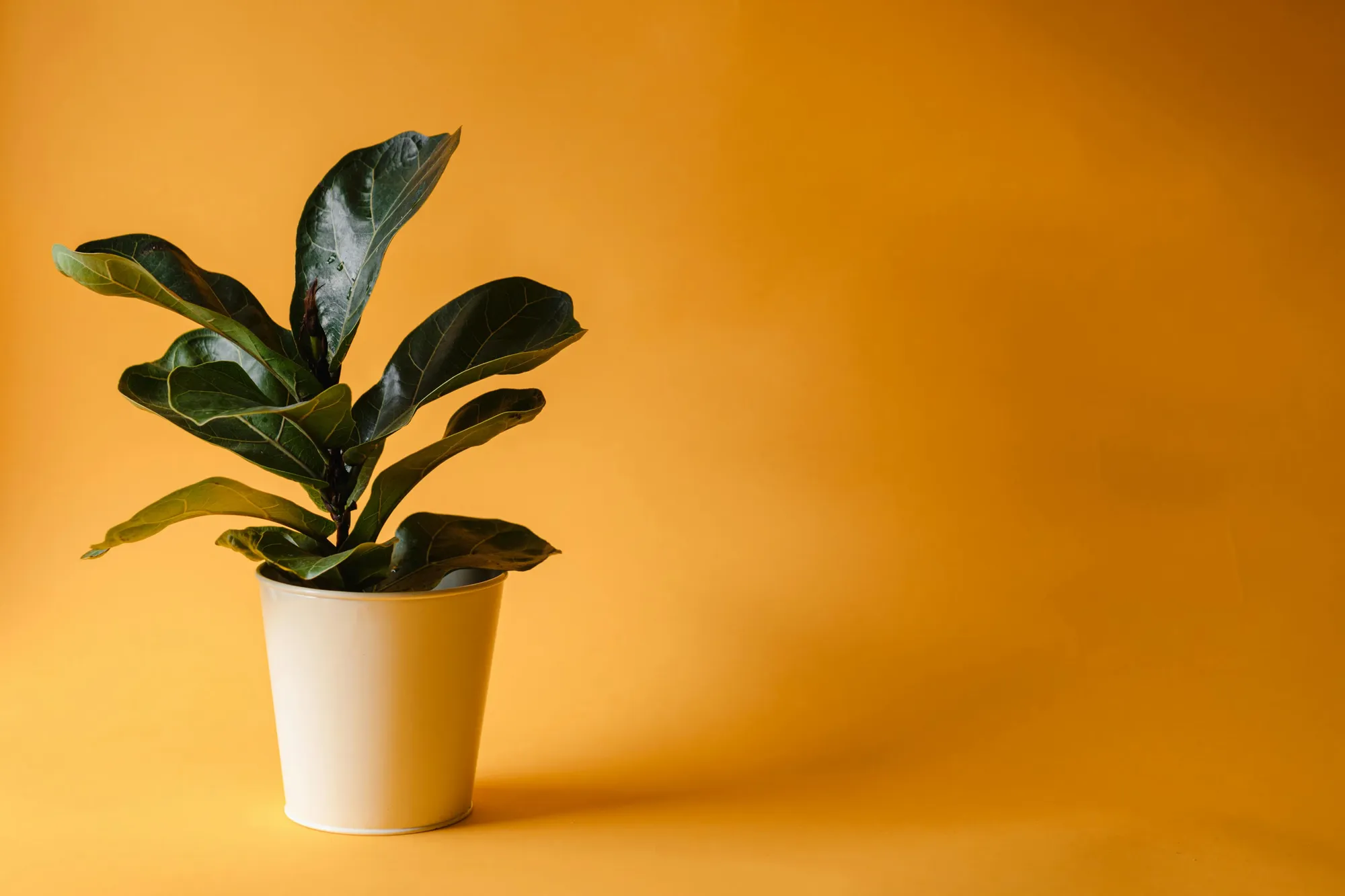Ficus lyrata (Fiddle-leaf fig): care, watering and expert tips

🌿 Quick summary:
- ☀️ Bright, indirect light for vibrant foliage.
- 💧 Water moderately; let the topsoil dry between waterings.
- 🌡️ Ideal temperature: 18–26 °C (65–78 °F).
- ✂️ Light pruning in spring.
- 🪴 Repot every 2 years for steady growth.
🌿 About the Ficus lyrata
The Ficus lyrata, better known as the fiddle-leaf fig, is a tropical plant native to West Africa.
Famous for its large, violin-shaped leaves, it’s one of the most popular indoor plants in modern interiors.
Elegant but slightly sensitive, it thrives in stable environments with good light and moderate watering.
🌿 Botanical profile
| Feature | Details |
|---|---|
| Scientific name | Ficus lyrata |
| Common name | Fiddle-leaf fig |
| Family | Moraceae |
| Origin | West Africa |
| Type | Tropical indoor plant |
| Mature size | Up to 3 m (10 ft) indoors |
| Light | Bright, indirect |
| Watering | Moderate, about once a week |
| Temperature | 18–26 °C (65–78 °F) |
| Humidity | Medium to high |
| Toxicity | Mildly toxic to pets and humans |
☀️ Light and placement
Your Fiddle-leaf fig needs plenty of bright light to keep its deep-green leaves shiny and healthy.
Place it near an east- or west-facing window, but avoid harsh direct sunlight that can burn the leaves.
💡 Tip: If your leaves turn dull or start falling, it’s often due to low light.
Avoid drafts and sudden temperature changes — this plant loves consistency.
💧 Watering and humidity
Water your Ficus lyrata only when the top inch (2–3 cm) of soil feels dry to the touch.
- Use room-temperature, non-calcareous water.
- Empty the saucer after watering.
- In winter, reduce watering to every 2–3 weeks.
🚫 Overwatering = root rot and leaf drop.
💦 Dry air = brown tips and curling leaves.
💡 Tip: Mist the leaves two or three times a week to maintain good humidity.
🌱 Soil and repotting
Best mix:
- 50 % universal potting soil
- 25 % perlite
- 25 % bark or peat
This mix ensures good drainage and healthy root development.
Repot every 2 years in spring, choosing a slightly larger pot.
Add clay pebbles at the bottom to prevent water stagnation.
🌾 Fertilizing
From March to September, feed your Ficus lyrata every 3 weeks with a balanced liquid fertilizer.
Reduce dosage if growth slows, and stop feeding during winter.
🌿 Dull leaves = lack of nutrients or insufficient light.
✂️ Pruning and maintenance
Lightly prune in spring to:
- control the height,
- encourage branching,
- remove damaged leaves.
Clean the leaves regularly with a soft, damp cloth to remove dust and enhance photosynthesis.
🧤 Tip: The sap can irritate skin — wear gloves when pruning.
🪴 Propagation
You can easily propagate a Fiddle-leaf fig by cutting:
- Take a stem cutting with 2–3 leaves.
- Cut just below a node.
- Place it in water or a soil + perlite mix.
- Keep warm (around 25 °C / 77 °F) and in bright, indirect light.
Roots form after 4–6 weeks.
🌳 Growing Ficus lyrata as a bonsai
Although not a classic bonsai species, Ficus lyrata can be trained into a miniature decorative form for advanced growers.
Its large leaves and stiff stems make shaping challenging but rewarding.
Specifics
- Regular pruning encourages smaller leaves.
- Wire only young branches — older wood breaks easily.
- Clean the latex sap immediately after cuts.
Bonsai substrate
40 % akadama, 30 % perlite or pumice, 30 % light potting soil.
Keep the mix slightly moist but never soggy.
Care tips
- Bright indirect light, 20–28 °C (68–82 °F).
- Mist regularly to maintain tropical humidity.
- Fertilize lightly every 4–6 weeks (April–September).
🌱 This “bonsai” form is more of a tropical decorative experiment than a traditional bonsai — ideal for enthusiasts looking for something unique.
🍃 Common problems and solutions
| Symptom | Cause | Fix |
|---|---|---|
| Falling leaves | Too much water or change of location | Let plant adapt, reduce watering |
| Soft leaves | Poor drainage | Repot in airy soil |
| Brown edges | Dry air | Increase humidity |
| Dull leaves | Lack of light | Move closer to a bright window |
🍀 Symbolism and benefits
The Fiddle-leaf fig represents stability, growth and inner strength.
Its broad leaves filter air pollutants and bring a calm, stylish atmosphere to any home or workspace.
🛠️ Useful accessories
🌿 To keep your Ficus lyrata thriving:
(Affiliate links verified by Verdepedia.)
⚠️ Mistakes to avoid
- Overwatering or leaving water in the saucer.
- Full sun exposure through glass.
- Moving the plant too often.
- Dry air and lack of humidity.
- No drainage hole in the pot.
🚨 Quick diagnostic guide
| Symptom | Cause |
|---|---|
| Yellow leaves | Overwatering |
| Dry leaves | Sunburn or dry air |
| Leaf drop | Environmental stress |
| No new growth | Low light or nutrient deficiency |
❓ Frequently asked questions
Q: Why are my fiddle-leaf fig’s leaves falling off?
A: Usually due to overwatering or moving the plant too often. Keep it stable and adjust watering.
Q: Why are the leaves brown at the edges?
A: The air is too dry — increase humidity or mist regularly.
Q: Can I prune my Ficus lyrata in winter?
A: It’s better to wait until spring for faster healing and regrowth.
Q: Can it be grown outdoors?
A: Yes, in warm climates (above 15 °C / 59 °F) and in bright, filtered light.
